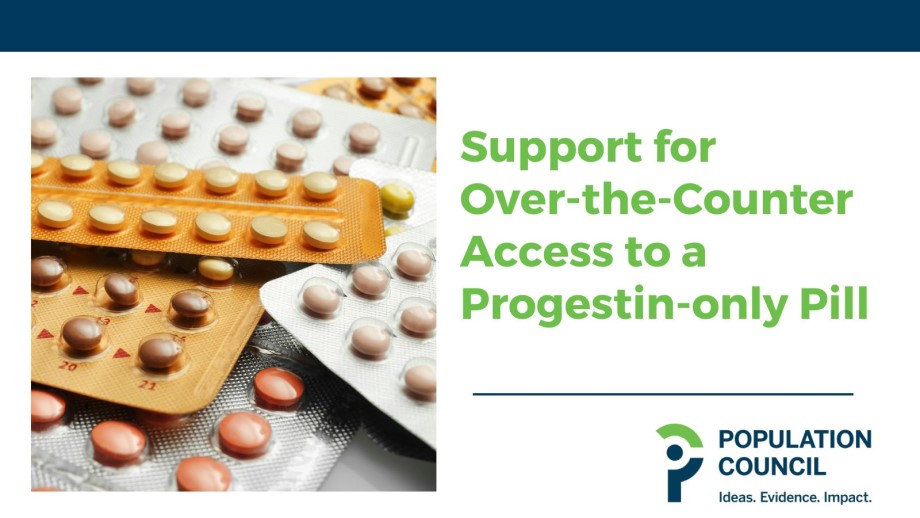
The Population Council believes that there is compelling effectiveness and safety data to support over-the-counter (OTC) status for oral contraception progestin-only pills (POP), such as Opill, the POP currently being reviewed by the US Food and Drug Administration (FDA).
The failure rate of a POP is currently reported to be the same as a combined oral contraceptive pill.[1] If taken correctly, fewer than 1 in 100 users taking a POP for contraception will get pregnant in one year. Even with typical use, POPs are about 93% effective.[1] Progestin-only methods, such as Opill, offer a strong safety profile and are generally regarded as safer than combined hormonal contraceptive products due to the lack of estrogen-related thromboembolic risk.[1] Since progestin-only pills do not appear to affect milk supply nor demonstrate harmful effects on infant growth, health, or development, the World Health Organization and other bodies support use of these methods during lactation. Levonorgestrel, the progestin used in Opill, is the most widely used progestin for contraception and has repeatedly demonstrated safety at higher doses in pills, implants, and intrauterine systems, and in 0.75mg levonorgestrel Plan B tablets available over-the-counter.[2]
Nearly half of all pregnancies in the US are unintended,[3] and 26 million Americans do not have health insurance.[4] The regulatory, logistical, and economic barriers experienced by those who would choose to use a POP are pervasive and prevent thousands of individuals from accessing safe and effective contraception. OTC status, a critical step towards addressing these barriers for some women, is appropriate when products such as Opill can be self-administered safely.
All products, whether prescription or OTC, should have clear and accurate user instructions, and easy-to-understand information about effectiveness, safety, and side effects. We have a large amount of use experience with progestin-only contraceptives, first licensed in the U.S. in the 1960s, to provide a strong scientific rationale for OTC status for many of these products.
The public health benefits for people at risk of pregnancy are clear—OTC access for a POP could dramatically decrease unintended pregnancy in the United States.[5] The demonstrated safety of progestin-only pills suggests a clear and positive benefit risk ratio to provide individuals at risk of pregnancy with this OTC additional option to manage their reproductive health and fertility. Currently, barrier methods are the only modern methods of contraception available without a prescription; POP products would provide a significantly more effective option for women.
To advance women’s health in the United States, the Population Council strongly urges the FDA to approve OTC status for progestin-only pills, including Opill.
1. Hatcher RA, Nelson AL, Trussell J, Cwiak CA, Cason P, Policar MS, et al. Contraceptive Technology 21st Edition. Managing Contraception, LLC; 2018. 1048 p.
2. Research C for DE and. Plan B (0.75mg levonorgestrel) and Plan B One-Step (1.5 mg levonorgestrel) Tablets Information. FDA [Internet]. 2022 Feb 7 [cited 2022 Oct 19]; Available from: https://www.fda.gov/drugs/postmarket-drug-safety-information-patients-and-providers/plan-b-one-step-15-mg-levonorgestrel-information
3. Unintended Pregnancy in the United States [Internet]. Guttmacher Institute. 2019 [cited 2022 Oct 19]. Available from: https://www.guttmacher.org/fact-sheet/unintended-pregnancy-united-states
4. Bureau UC. Health Insurance Coverage in the United States: 2019 [Internet]. Census.gov. [cited 2022 Oct 19]. Available from: https://www.census.gov/library/publications/2020/demo/p60-271.html
5. Guillard H, Laurora I, Sober S, Karapet A, Brass EP, Glasier A. Modeling the potential benefit of an over-the-counter progestin-only pill in preventing unintended pregnancies in the U.S. Contraception. 2023 Jan 1;117:7–12.
